The right software development approach determines the success of the project. In 2025, current trends are AI, Quantum and edge computing, blockchain for software security, and more. The software development life cycle is a step-by-step process where the development team builds high-quality software in the given time frame.
Software Development Approach: A Guide for Businesses in 2025
A software development approach can give your product the right start, secure it with optimal compliance standards, architect it for easy adaptation to change, and ultimately make it value-driven for the business in the digitalized era.
The approach you select for developing your project will significantly impact its long-term sustainability, adaptability, and even your business's reputation.
This guide will help you develop innovative software products to enhance your digital business.
Let's begin with a basic overview of software development!
Software Development Overview
Software development involves 7 steps that include ideation, roadmap creation, architectural designing or prototyping, development and coding, testing (includes QA), deployment, and continuous maintenance support.
Software is not merely a coded and programmed IT product. Since, running a business implies working with software products having various features and functionality, all making operations efficient.
Are you planning to launch a software? Great!
This is the perfect time to invest in the software industry. Statista predicts a whopping $858.10 Billion annual growth in business software revenue by 2028.
Types of Software Development
Here is a preview of 9 types of software development that you will introduce, in brief.
-
Web App Development
-
Desktop App Development
-
Game Development
-
Mobile App Development
-
Wearable Software Development
-
Security Software Development
-
Cloud Computing Software Development
-
API Development
-
Embedded Systems Development
Software Development is an extensive domain with specialized areas for every need, each with its own unique focus and goals.
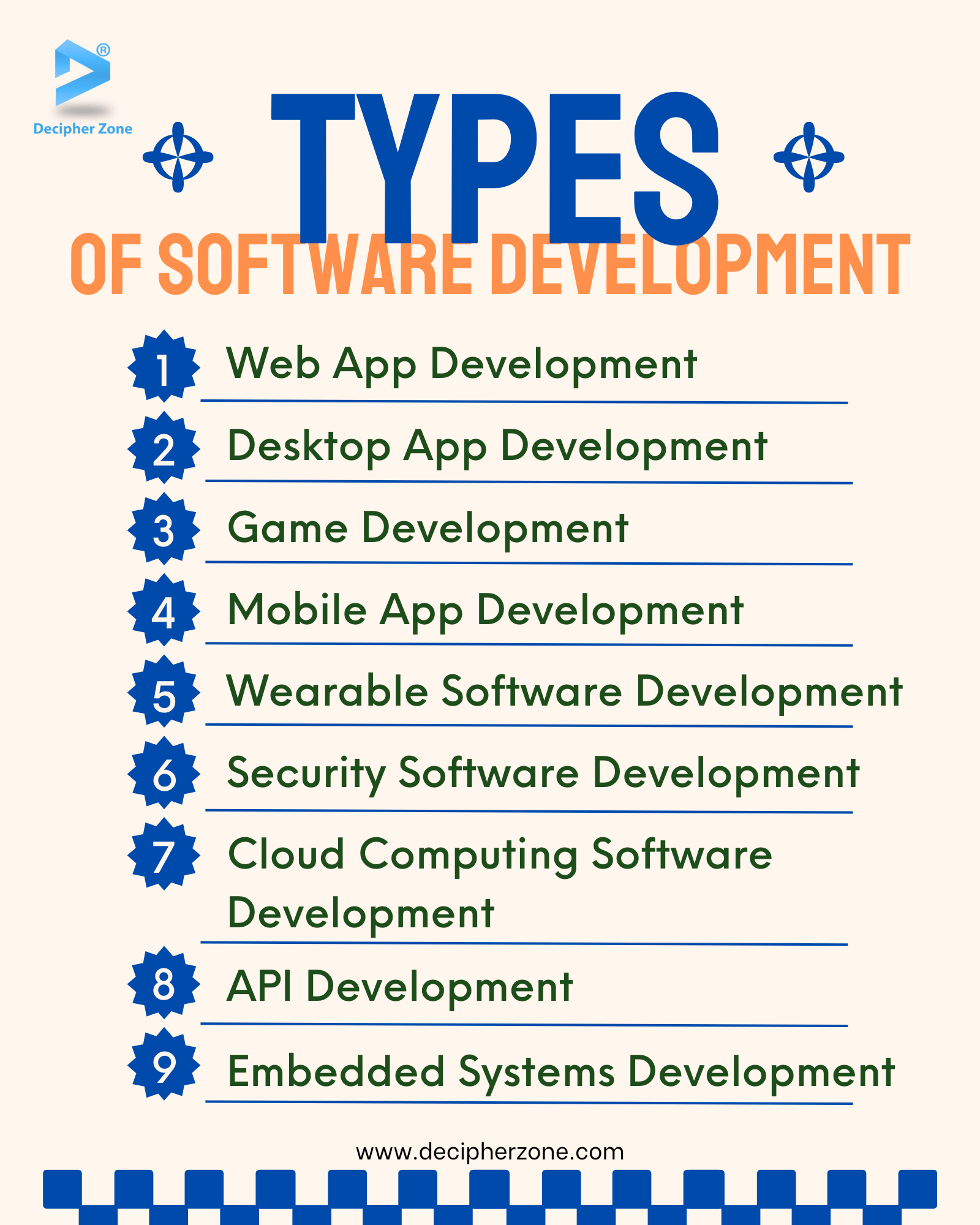
1. Web App Development
Mainly, Web Apps are a process of designing, building, testing, and deploying web-based applications that will be installed on remote servers and are delivered to the end users through web browsers over the internet.
Read: CAD Software Development
2. Desktop App Development
Desktop Applications are software programs that run on top of operating systems such as Linux, Microsoft Windows, macOS, and Unix. These programs are built to be used specifically on desktops and laptops.
3. Game Development
Game Development involves the idea of generation, design, build, test, and launching of a game that lets the player interact with content and is able to manipulate the game’s elements.
4. Mobile App Development
Mobile App Development is a customized application that can run specifically on mobile devices and tablets and utilize network connectivity to interact with remote computing resources.
5. Wearable Software Development
Wearable Software Development is the process of designing and developing software that retrieves data from wearable devices such as smartwatches or smart glasses. Wearable devices not only provide fitness tracking, but also connections to audio, integrated camera buttons, health tracking, and more.
6. Security Software Development
Security Software Development is the concept of implementing mechanisms in the construction of security to help it remain functional and resist attacks for example antivirus. In other words, the security software is designed to avoid unauthorized access and malicious attacks from laptops, mobile devices, and servers.
7. Cloud Computing Software Development
This allows the creation of software in a virtual environment for project management, and automatic testing. Usually with pay-as-you-go pricing, cloud computing provides hosting services and IT resources such as Microsoft Azure, AWS, and App Engine over the Internet.
8. API Development
Application Programming Interface (API) development allows a software system to add features or services to other applications and platforms. In other words, API allows various applications to communicate with each other securely.
9. Embedded Systems Development
Embedded systems refers to microprocessor-based software that is designed to perform dedicated tasks and functions within large operating systems.
Embedded systems can be commonly found in sectors including industrial, telecommunication, automotive, commercial, home appliances, medical, and military applications.
Key Factors Impact Your Project
Choosing the right software development approach requires heedful consideration. Below are 4 major factors to consider that can impact your project's success.
-
Complexity
The requirement of no-code, low-code and pro-code platforms depends on the complexity and needs of the project. If you're creating a basic internet tool, a no-code platform may suffice.
However, if you're working on a complex data management system that requires advanced features, you will likely need a customization option that low-code and pro-code solutions can offer.
Moreover, complexity is not just the number of features but how those features interact, the date they process and the problem they solve.
-
Time
In today's ever-changing business environment, Time is the primary essence that works with the quality of the project. Low-code platforms mainly allow for rapid creation and launching, enabling you to get your project off the ground faster than traditional full-code solutions.
However, it's not just about speed; the key part is the output quality within that time that can only be achieved through pro-code development.
-
Budget
Creating a budget-friendly project with all the features required is vital, especially for small or medium-sized businesses that can’t afford the expensive full-code solutions. It's important to consider not only the initial development cost, but also ongoing expenses such as maintenance, updates, and potential modifications.
If you can’t afford low-code or pro-code solutions, no-code platforms may provide reasonable or inexpensive solutions but at the cost of security risks and minimal customization options.
-
Skill Level
Consider the skill level of your team to identify team appropriateness. Low-code platforms are suitable for those with minimal coding skills however if you require a full-code project you need to outsource an offshore software development company.
Software Development Outsourcing Models
Software Development Outsourcing Models are intended by the distance between the client and the software development company or service providers. Here are some of the outsourcing models to consider.
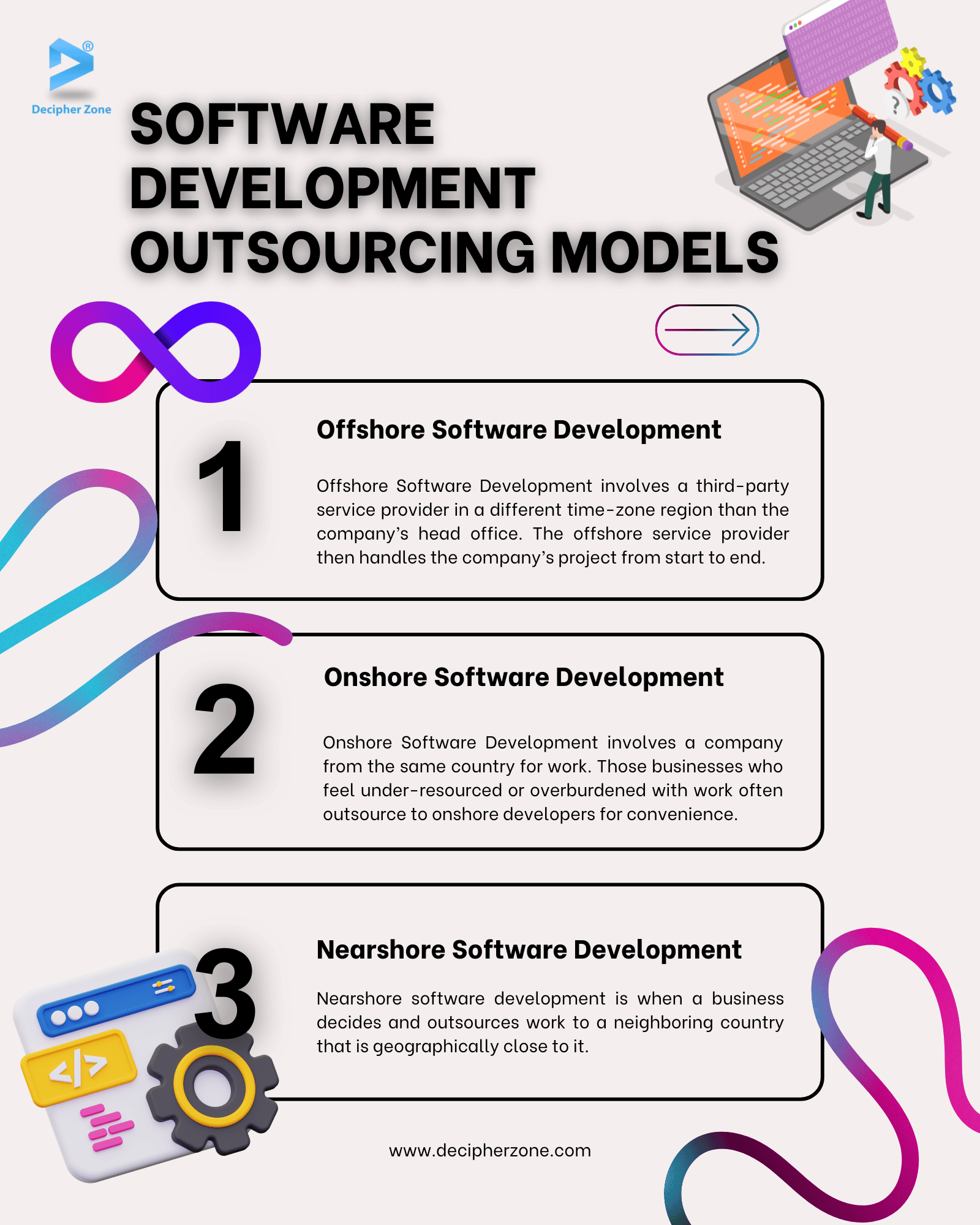
Read: Best Software Development Models
1. Offshore Software Development
Offshore Software Development involves a third-party service provider in a different time-zone region than the company’s head office. The offshore service provider then handles the company’s project from start to end. It includes the customization, development, and testing of features and functionality and a user-friendly interface.
Offshore software developers offer a few services such as
-
Web App development
-
Mobile App Development
-
Cloud-based App Development
-
App Modernization
-
Desktop App Development
-
Software Architecture Integration
-
API Development & Integration
-
Software Testing
-
Research and Study
-
User Experience (UX) Design
2. Onshore Software Development
Onshore Software Development involves a company from the same country for work. Those businesses who feel under-resourced or overburdened with work often outsource to onshore developers for convenience.
3. Nearshore Software Development
Nearshore software development is when a business decides and outsources work to a neighboring country that is geographically close to it. This approach is typically used for medium to large-scale projects that may require handling confidential information or where security is a priority.
By outsourcing to a nearby country, the company can have immediate access to the developers and ensure better communication and collaboration.
Benefits of Outsourcing Software Development Company
Before availing of the outsourcing service it is necessary to know the benefits of it. Some of them are listed below.
-
Save time & money
Working with an outsourcing software development company allows businesses to reduce some of the costs associated with internal business aspects. This provides a price advantage over competitors. Instead of recruiting individuals and setting up an IT department, delegating tasks to an outsourcing company is more advantageous.
-
Scalability
At the stage of development, businesses need to improve their IT support. Internal team expansion in the business to meet changing needs can be costly and time-consuming.
However, Outsourcing can provide the necessary resources to increase any project for clients. Businesses can have access to a database and have the flexibility to quickly enhance a project’s resource allocation.
-
24*7 Service
One of the significant benefits of software outsourcing is the ability to collaborate with outsourcing companies located in different time zones. It becomes effortless to provide customers with overlapping hours of service, regardless of their location in the world.
Businesses can create a suitable overlap system to meet their needs. This implies that software development companies can provide clients with almost complete coverage 24/7.
-
Quicker turnaround time
By demonstrating the system analysis of the issue and the creation of a project plan, the development team including developers, project managers, testers, and DevOps, can begin project development right away. This means the deployment of the product or services on the market a lot quicker.
-
Improved compliance and less risk
Outsourcing software development business offers a significant advantage of owning the rights to the generated software. This includes all the necessary information and a complete transfer of ownership of the generated software and information system, whether the business is a large enterprise or a small startup.
Strategies to The Right Software Development Approach
It is normal to have doubts about the technical feasibility of software development which can be answered by the development team working with you. However, some strategies are outlined to consider the right approach at the initial stage.
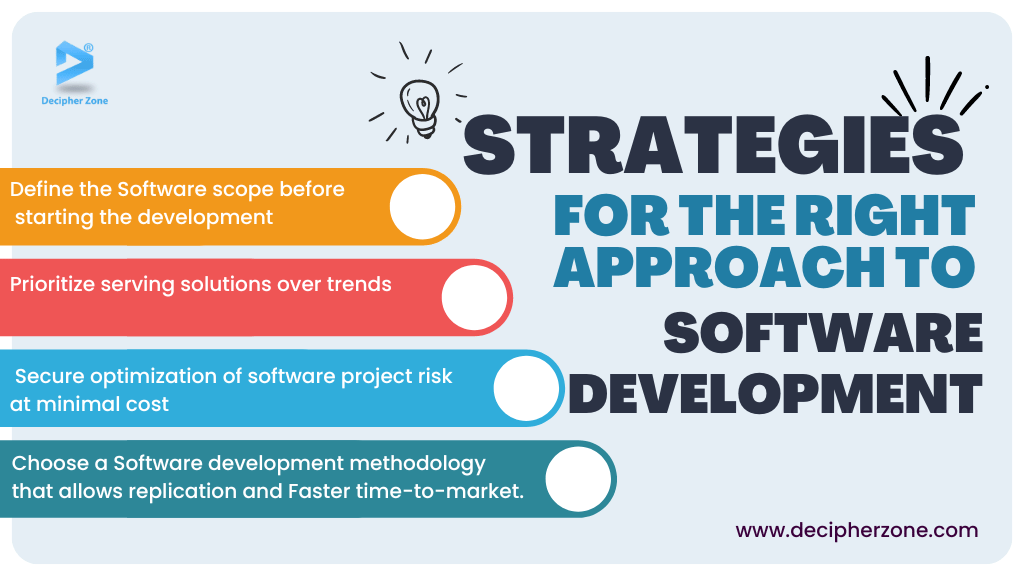
Read: Cloud-Based Software Development
Strategy 1- Define the Software scope before starting the development.
This strategy involves a few questions to answer those the software scope can be clearly stated. Here is a list of questions.
-
How will software help the audience?
-
How pertinent the software is to the current trend?
-
What features stand your software apart from the competition?
-
How much profit or revenue do you expect from the software launch?
-
What are the software launch plans?
-
Does MVP development better suit the project agenda?
A well-defined software scope is the foundation of your project that helps fulfill the rightful execution, top-notch quality product, and the intended results.
Strategy 2- Choose a Software development methodology that allows replication and Faster time-to-market.
This is a key strategy or approach businesses have started adapting for the project’s success on a friendly budget. Agile software development is a strong strategy for building top-notch quality software and promotes speed and efficiency through the strategy.
There are a few steps in the agile software development process where it follows the 12 principles mentioned by the Agile Manifesto. The steps are mentioned below.
-
Planning and creating a roadmap for your project.
-
Divide the project into smaller milestones and plan their launch as MVP.
-
Holding regular meetings to review progress and bottlenecks.
-
Developing and delivering the prototype.
-
Reviewing with the testing team.
-
Holding retrospective meetings with the project owner, development team, and other team members.
Strategy 3- Prioritize serving solutions over trends.
The software realm is pounding with significant advancements each day. There is always something new and better to incorporate into your software, whether it's new technology development, an updated framework, or the emergence of new development tools.
Many businesses prioritize tech trends rather than focusing on serving the right solution to the target audience. This creates disorientation from the set goals and requirements. Therefore, the foremost priority of businesses is to serve the right solution with the software rather than keeping up with the industry trend.
Strategy 4- Secure optimization of software project risk at minimal cost
Implementing a secure software development life cycle (SDLC) is a quick-witted approach that works to rectify the quality of the product and enable attaining a fine level of robustness at an optimized cost. The implementation of the security solutions of some businesses can miss out if focusing on catching the fast-changing growing environment.
Different Software Development Methodologies
Here is an overview of some software development methodologies which are commonly used.
1. Agile Methodology
Agile Methodology is a set of rules that allow the team to work more efficiently and seamlessly. Most companies use this methodology to reduce the risk of bugs, cost overruns, and changing needs. Iterative and incremental projects are well-suited to this approach.
2. Waterfall Methodology
Water methodology is a sequential approach that flows in one direction like a waterfall. This approach includes a few steps: requirements, design, implementation, verification, and maintenance. The method requires focus and clear requirements as it is difficult to make changes once the project is in the development process.
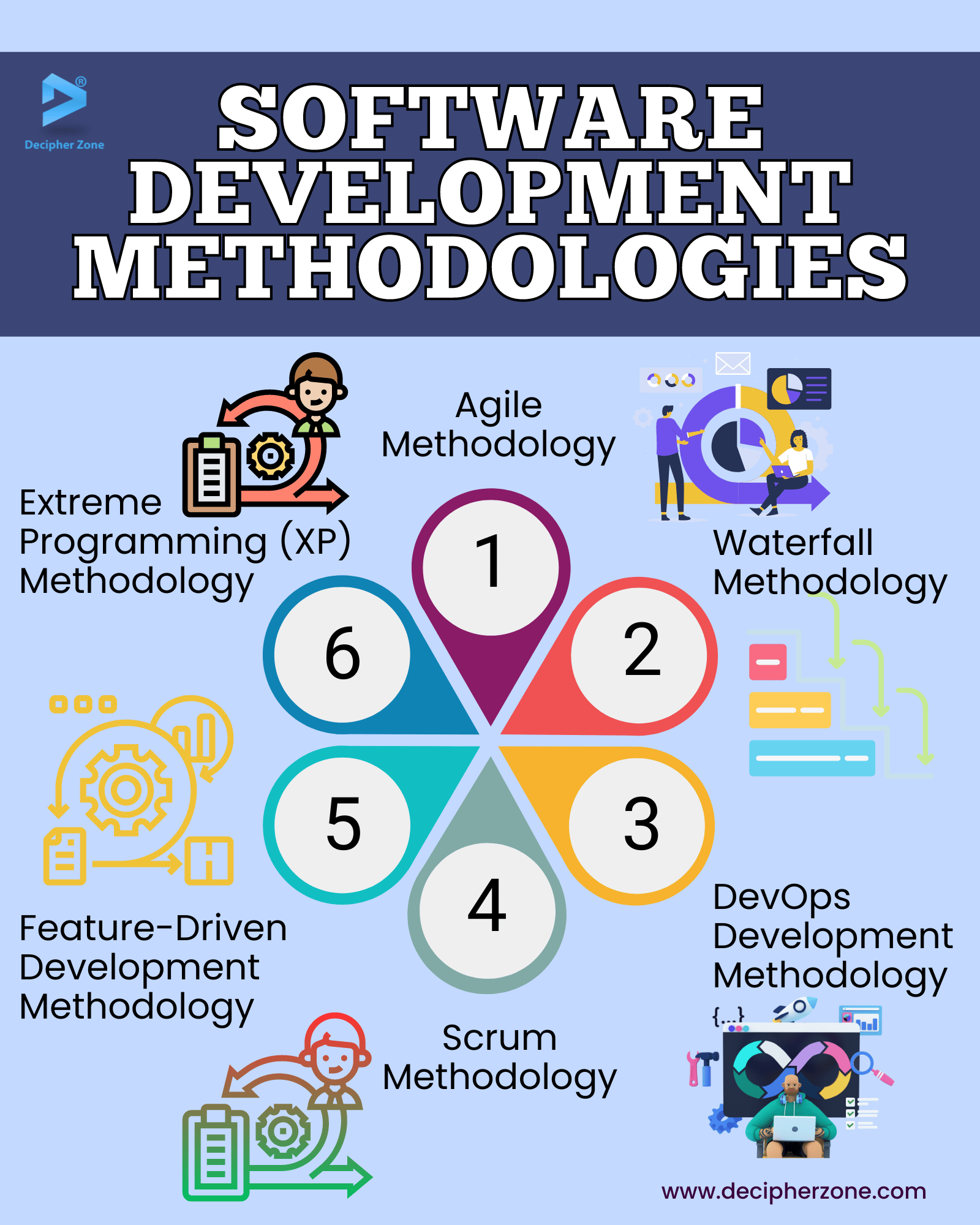
3. DevOps Development Methodology
DevOps is a set of organizational practices by which the internal software team operates and collaborates consistently to fulfill the project on time and within budget attaining business goals.
Throughout the app development process, the development and operation teams work in sync via proper communication channels.
4. Scrum Methodology
Scrum is a software development life cycle methodology that focuses on continual and progressive app development. The Scrum manager segregates the project into minor tasks depending on the client’s project requirements and allocates them to different team members. This technique makes it simple to obtain specific objectives by iterations.
Read: Course Creation Software Development
5. Feature-Driven Development Methodology
This methodology involves the process of developing individual features of the software and then inspecting them for approval from the client before moving on to the next feature.
The process is based on short replications that are critical for completing projects on time. The feature-driven development methodology is cost-efficient by estimating the cost depending on the features that are integrated into the project.
6. Extreme Programming (XP) Methodology
This methodology is intended to improve software quality and responsiveness to changing client requirements and launch it at speculative time frames.
It incorporates concepts such as test-driven development and code review to maintain beneficial incremental development techniques and accomplish substantial achievements.
Now that we understand the different aspects of software development, let’s explore the Software Development Life Cycle.
Software Development Life Cycle
The Software Development Life Cycle (SDLC) outlines the specific tasks that need to be performed by developers at different stages of the software development process. SDLC ensures the possibility of meeting client’s expectations and fulfilling their requirements within the overall budget.
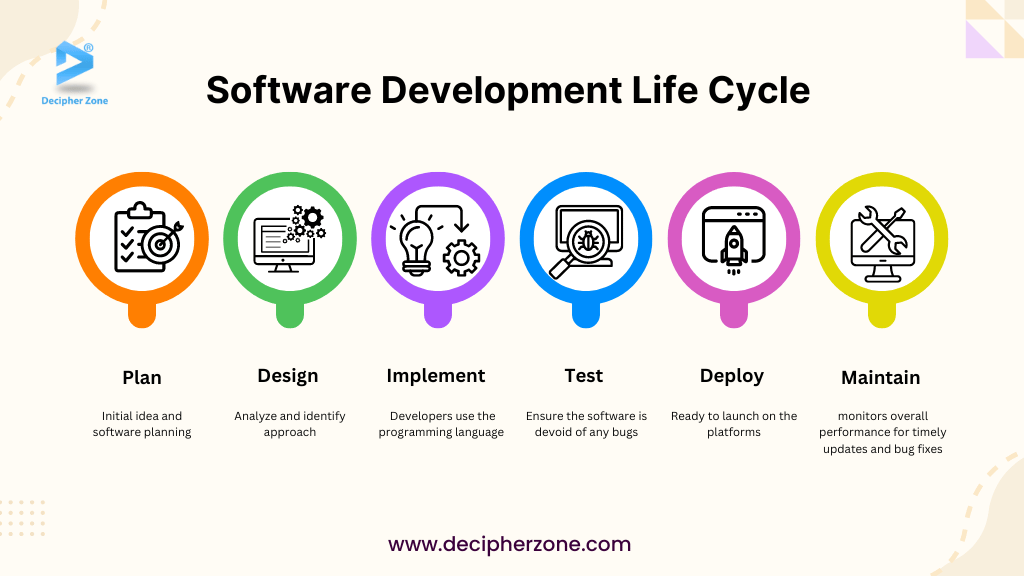
Plan
The first step in SDLC is the planning of tasks such as cost-effective benefits analysis, scheduling, resource evaluation and allocation. A customer software specification document is created, which comprises all the requirements gathered from internal and external experts, managers, and clients themselves.
This document makes it easy to evaluate specific goals and requirements. The team then estimates costs and formulates a detailed layout to achieve the goals.
Design
The second step is to analyze the requirements and identify the most effective approach to create software. The developers ought to look for the pre-existing modules and identify development tools to integrate into the new software. Moreover, some programming languages are used such as JavaScript, Python, TypeScript, Java, C#, C++, PHP, and Rust.
Implement
This is the third and the longest step of the development process. This step includes the division of the tasks into smaller modules or units and assigning them to different developers to do daily to achieve the final result.
Developers then begin to make the entire system and use the programming language chosen as well as programming tools such as interpreters, compilers, and debuggers to implement the code.
Test
The testing phase is usually conducted in parallel with the development of software. The development team utilizes both manual and automation testing to ensure that the software is devoid of any bugs. T
his process continues until the software becomes stable, faultless, and functions in accordance with the client's requirements and needs.
Deploy
In the fifth step, the software is ready to deploy once the testing is complete. The software given for customer use is called production and the other with the development team is called build environment.
This build environment allows the development team to update and change the features, code and functionalities while the customer is using the software.
Maintain
The sixth step is critical to ensure customer satisfaction and uninterrupted service. Once the software is installed and in regular use, the development team monitors overall performance, security, and user experience for timely updates and bug fixes.
Software Development Challenges & Solutions
While software development there are many challenges faced, yet to understand and overcome them a few of the challenges are listed below with their solutions.
1. Software Development Expectations and Final Outcome
Problem: Constantly changing requirements can take time to stay on track and maintain the quality of the ideal product. It is therefore crucial to establish a specific framework for managing changes and ensuring that the final product meets the requirements of the client.
Solution: A systematic approach and strong communication will determine whether the final product meets the client's needs. Follow the proven approaches listed below,
-
Consider the client’s needs before working on the project.
-
Effective communication about ideas and requirements to the development team.
-
Develop a thorough, clear, incisive software specification document.
-
Develop a project prototype to test and refine the final ratified requirements.
2. Difficulty in Estimating Time and Resources
Problem: Insufficient resource allocation issues while developing software.
Solution: By visualizing the entire project and dividing it into small tasks, project managers can evaluate the exact time and resource frame. This provides a better insight into calculating and managing the workload concurrence defined timeline.
3. Lack of Resources for the Software Development Process
Problem: The process of software development demands a variety of resources such as advanced technologies, tools, and skilled developers. However, sometimes the biggest challenge can be a lack of skilled developers, budget constraints, limited tools, and outdated technology stacks.
This can ultimately hamper the quality of the final product and even lead to project delays.
Solution: By analyzing the work done by developers, you can save time, resources, and funds that can be utilized in other areas of your business. Ultimately, opting for outsourcing services is a cost-effective way to maintain quality and can be a solution to the challenge of managing your workload efficiently and effectively while still maintaining high standards of quality.
4. Strict Time Constraint
Problem: Developers are restricted to deadlines given by the client however the deadlines might not justify the features and tools the project requires. Sometimes the work is done before the deadline, and sometimes the given deadline is not enough to complete the work on the project. This creates frustration and increases the workload on the developers which can ultimately hamper the quality of the project.
Solution: To deal with this challenge the development team can emphasize more on time management. Also setting realistic deadlines and discussing the client’s expectations at the start increases the chances of meeting deadlines.
5. Testing & Debugging
Problem: Identifying errors and determining how to fix them is a challenge as sometimes developers are too occupied with other work making them less attentive to the bugs in code. At times, there is a risk of bugs and errors occurring even after the testing process which can frustrate the developers and end-users.
Solution: To deal with this challenge, adopting a test-driven development (TDD) approach can help. By this developers can focus on writing code that can pass the test. Hence, reducing the chances of bugs and errors. Moreover, developers can use debugging tools and cross-check each other's codes to help ease the development process.
6. Maintaining the Competitive Edge
Problem: In this continuously changing technology landscape, the rate of businesses offering similar products and services is growing. Thus, it is necessary to have USP to remain competitive and even stand out from the competition.
Solution: Following the latest trends and improving the projects accordingly can help you deal with this challenge. Moreover, software development businesses can invest in research and development (R&D) initiatives to identify growth opportunities. This initiative ensures the evolution of the company and its products and services offerings.
7. Neglecting Quality Assurance
Problem: Underscoring can cause significant software crashes, which can lead to costly downtime and lost productivity. That's why it's crucial to prioritize quality checks and testing to catch any sight errors early on.
Solution: This challenge can be dealt with by setting achievable, small milestones to ensure the work is moving in the right direction. Also, encourage the development team to utilize the best practices and coding standards to meet the client’s requirements effectively and efficiently.
8. Security Challenges
Problem: In the software development industry, security is a major challenge due to the increasing number of data breaches, cyber thefts, and other cybersecurity threats.
Solution: To avoid unforeseen software challenges regarding security use the below best practices,
-
Use the right software with pre-built security features.
-
Don’t rely on technology to enhance security.
-
Perform security measures and implement security assurance activities.
Read: Sales Management Software Development
Top Software Development Trends to Follow in 2025
Following trends and developing innovative solutions can be a way to be successful. Following are some trends to keep in mind while developing a software in 2025
1. AI-powered
Developers can look forward to AI becoming an indispensable partner in their work. The integration of Artificial Intelligence (AI) into the software development industry is set to accelerate, leading to increased productivity and better decision-making throughout the development process.
Moreover, AI offers efficient error detection and seamless error fixing, making the development process smoother and more streamlined.
2. Quantum Computing Integration
Quantum computing integration can revolutionise tasks including data encryption, optimization and complex simulations. Moreover, developers can explore new algorithms and computational models, thus ushering in a new era of possibilities.
3. Edge Computing
Edge computing is becoming essential to software development as it brings real-time processing and increases the proliferation of IoT devices. Developers can prioritize edge computing, improving performance by reducing data processing latency and bringing computation closer to the source.
4. Blockchain for Software Security
With its well-known security properties, blockchain technology will be a hype in the software development industry. From robust identification management to unbreakable code repositories, blockchain will play a critical role in improving software security and reliability.
5. Collaborative Development Environment
Real-time collaboration, code sharing, and project management tools will enhance productivity in the era of remote work. To prompt seamless communication and cooperation between the development team, the collaborative development environment will continue to evolve.
6. Internet of Behaviour (IOB) for personalization.
Due to IoT and IoB, it is easy to track, merge and evaluate massive data created by different types of online activities and personal behavior such as social media habits, and commercial transactions. Moreover, the Internet of behavior can replace time-consuming customer surveys for businesses and corporations.
What Decipher Zone Offers?
The team at Decipher Zone provides a range of software development services, including web and mobile app development, e-commerce applications, and full-stack development.
They also offer DevOps and QA and testing, and you can hire developers for data analytics, business intelligence, and UX/UI design. The expert developers in our team can provide optimized software solutions within your budget.
Are You Ready?
The software development industry is constantly evolving, with new trends emerging all the time. However, it's important to focus on the optimal utilization of the app, taking into account the current trends, to ensure its success. If you follow the best practices mentioned in the blog, you can develop trending software with optimum resources.

Want to get a free consultation before outsourcing the development team? Contact us to book an appointment today!

